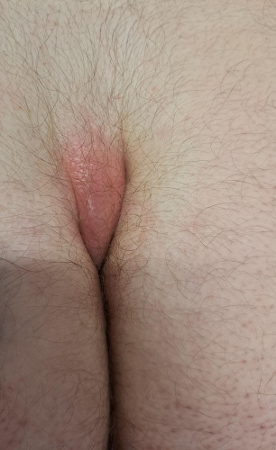Summary
Definition
History and exam
Key diagnostic factors
- sacrococcygeal discharge
- sacrococcygeal pain and swelling
- sacrococcygeal sinus tracts
Other diagnostic factors
- at risk demographic (male, age 15 to 45 years, hirsutism)
- modifiable risk factors (prolonged sitting, perineal hygiene)
- history of prior rupture of fluid into natal cleft
- skin maceration
- acutely increased natal cleft pain and swelling
- fever
Risk factors
- male sex
- age 15 to 45 years
- prolonged sitting
- hirsutism
- frequency of bathing
- overweight
- family history of pilonidal disease
Diagnostic tests
1st tests to order
- clinical diagnosis
Treatment algorithm
asymptomatic
symptomatic with abscess
symptomatic chronic or recurrent disease
Contributors
Authors
Brandon C. Chapman, MD, MS
AdventHealth
Parker Adventist Hospital & Castle Rock Adventist Hospital
CO
Disclosures
BCC declares that he has no competing interests.
Acknowledgements
Dr Brandon C. Chapman would like to gratefully acknowledge Mr Iain J.D. McCallum and Dr Seamus Kelly, both previous contributors to this topic. IJDM and SK declare that they have no competing interests.
Peer reviewers
Maher A. Abbas, MD, FACS, FASCRS
Assistant Clinical Professor of Surgery
UCLA
Chief of Colon and Rectal Surgery Chair
Center for Minimally Invasive Surgery Kaiser Permanente
Los Angeles
CA
Disclosures
MAA declares that he has no competing interests.
Angus J.M. Watson, FRCS (Ed)
Consultant Colorectal Surgeon
Clinical Manager of General Surgery and ETC
Department of Surgery
Manchester Royal Infirmary
Manchester
UK
Disclosures
AJMW is an author of a reference cited in this monograph.
Peer reviewer acknowledgements
BMJ Best Practice topics are updated on a rolling basis in line with developments in evidence and guidance. The peer reviewers listed here have reviewed the content at least once during the history of the topic.
Disclosures
Peer reviewer affiliations and disclosures pertain to the time of the review.
References
Key articles
Gil LA, Deans KJ, Minneci PC. Management of pilonidal disease: a review. JAMA Surg. 2023 Aug 1;158(8):875-83. Abstract
Johnson EK, Vogel JD, Cowan ML, et al. The American Society of Colon and Rectal Surgeons' clinical practice guidelines for the management of pilonidal disease. Dis Colon Rectum. 2019 Feb;62(2):146-57.Full text
Segre D, Pozzo M, Perinotti R, et al. The treatment of pilonidal disease: guidelines of the Italian Society of Colorectal Surgery (SICCR). Tech Coloproctol. 2015 Oct;19(10):607-13. Abstract
Reference articles
A full list of sources referenced in this topic is available to users with access to all of BMJ Best Practice.

Differentials
- Perianal fistula
- Perianal abscess
- Hidradenitis suppurativa
More DifferentialsGuidelines
- The American Society of Colon and Rectal Surgeons’ clinical practice guidelines for the management of pilonidal disease
- Practice parameters for the management of pilonidal disease
More GuidelinesLog in or subscribe to access all of BMJ Best Practice
Use of this content is subject to our disclaimer